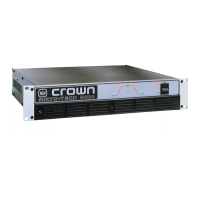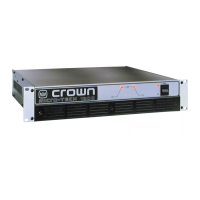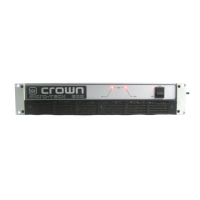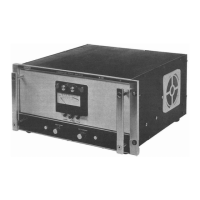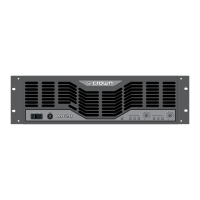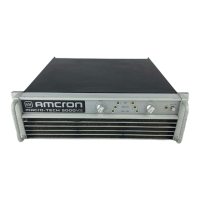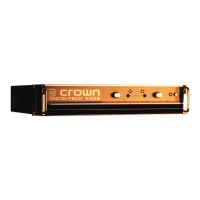Page 20
Micro-Tech 600/1200/2400 Power Amplifiers
4.3.4 Transformer Thermal Protection
All
Micro-Tech
amplifiers have transformer thermal pro-
tection. The amplifier’s transformer thermal protection
circuitry is activated in very unusual circumstances
where the unit’s transformer temperature rises to un-
safe levels. Under these abnormal conditions, the am-
plifier will remove power from the affected channel’s
high-voltage power supply which puts the channel in
drive protection mode. The amplifier channel will re-
turn to normal operation after its transformer cools to a
safe temperature.
It is extremely unlikely that you will ever see a
Micro-Tech
amplifier activate transformer thermal pro-
tection as long as it is operated within rated conditions
(see Section 6). One reason is that
ODEP
keeps the
amplifier working under very severe conditions. Even
so, higher than rated output levels, excessively low-
impedance loads and unreasonably high input signals
can generate more heat in the transformer than in the
output devices. These conditions can overheat a trans-
former and activate its protection system.
Micro-Tech
amplifiers are designed to keep working
under conditions where other amplifiers would fail. But
even when a
Micro-Tech’s
limits are exceeded, it will
still protect itself—and your investment—from damage.
4.3.5 Fuses and Circuit Breakers
120 VAC, 60 Hz models and all
Micro-Tech 2400s
have
an internal fuse that protects the low-voltage supply
and cooling fan.
Micro-Tech 600
and
1200
high-volt-
age supplies are protected by internal fuses, while
Mi-
cro-Tech 2400
high-voltage supplies are protected by
circuit breakers. With rated loads and output levels,
the fuses (or circuit breakers) should only shut down
the amplifier in the rare instance of a catastrophic fail-
ure.
ODEP
protection keeps the amplifier operational
under most other severe conditions. The fuses (or cir-
cuit breakers) can also shut down the amplifier in cases
where extremely low-impedance loads and high out-
put levels result in current draw that exceeds their rat-
ing. Again, this should only be possible when operating
outside rated conditions
like when the amplifier is used
to drive a 1 ohm load in Stereo mode, or when an input
signal is clipped severely.
Micro-Tech
amplifiers do not blow their fuses or trip
their breakers unless something is wrong. In the rare
event that an internal fuse blows, please refer the unit
to a qualified technician. If a breaker in a
Micro-Tech
2400
trips, try to identify and correct the problem be-
fore resetting the breakers. If the problem persists, re-
fer the unit to a qualified technician.
power is needed from the output devices than they
can deliver under the present conditions,
ODEP
imme-
diately limits the drive level until it falls within the SOA.
Limiting is proportional and kept to an absolute mini-
mum—only what is required to prevent damage. Un-
der normal conditions, no limiting is required and
ODEP
is transparent to the audio signal.
This level of protection enables Crown to increase out-
put efficiency to never-before-achieved levels while
greatly increasing reliability. As described previously,
ODEP
operation is monitored by the front panel
ODEP
indicators. They show whether the amplifier is function-
ing correctly or if
ODEP
is limiting the drive level.
With
ODEP
you get maximum power with maximum
protection so the show goes on.
4.3.2 Ultrasonic and Radio Frequency Protection
Micro-Tech
amplifiers have a controlled slew rate. This
means that their design limits the frequencies they can
reproduce. At the same time, the amplifier’s controlled
slew rate has no effect on its audio performance be-
cause limiting occurs well above 20 kHz. This ap-
proach protects the amplifier from radio frequencies,
and also protects some sensitive loads (like tweeters).
In the real world, an amplifier’s slew rate only needs to
be large enough to deliver the maximum voltage at the
highest required frequency—higher slew rates actu-
ally allow the reproduction of undesirable frequencies.
4.3.3 Drive Protection
The drive protection system temporarily removes drive
from the output stages to protect the amplifier and its
load(s). Drive protection can be activated in two situa-
tions. First, if dangerous subsonic frequencies or di-
rect current (DC) is detected in the amplifier’s output,
the unit will activate its DC/low-frequency protection
circuitry which puts the affected channel in drive pro-
tection mode. This protects the load(s) and prevents
oscillation. The amplifier resumes normal operation
when it no longer detects dangerous output. Although
it is extremely unlikely that you will ever activate the
amplifier’s DC/low-frequency protection system, im-
proper source materials like subsonic square waves or
a severely clipped signal can activate this system.
The amplifier’s fault protection system puts the affected
channel into drive protection mode in rare situations
where heavy common-mode current is detected in its
output. The amplifier should never output heavy com-
mon-mode current unless its circuitry is damaged.
Activating drive protection helps prevent further dam-
age.

